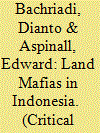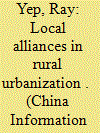|
|
|
Sort Order |
|
|
|
Items / Page
|
|
|
|
|
|
|
| Srl | Item |
| 1 |
ID:
193131


|
|
|
|
|
| Summary/Abstract |
In Indonesia, “land mafias” (mafia tanah) proliferate, alongside mafias that cluster around other commodities and state functions. We analyze the composition, character, modes, and sources of resilience of Indonesian land mafias, noting similarities with formations elsewhere, especially India. While taking care to avoid reifying the category, we view land mafias as opportunistic networks, or assemblages, of diverse actors including land brokers, investors, lawyers, gangsters, bureaucrats, law enforcement officers, and politicians. Their goal is to harvest rents from the transfer of ownership and control over land. They feature two elements: first, reliance on coercion (not always physical violence but always entailing transfer of property without freely-given consent, often via fraud or manipulation); second, institutional amorphousness crossing the state-society boundary. We analyze four modes of land mafia operation, though their nebulousness defies easy categorization. In explaining land mafia resilience, we acknowledge Indonesia’s property boom as a driver, but note that the ubiquity of mafias points to a more fundamental explanation: a variety of state formation involving pervasive engagement by state actors in illegal behavior in collusion with wealthy private actors. Mafias are central to Indonesian state formation, rather than aberrations. Feedback loops that incentivize illegal behavior make land mafias difficult to eradicate.
|
|
|
|
|
|
|
|
|
|
|
|
|
|
|
|
| 2 |
ID:
173250


|
|
|
|
|
| Summary/Abstract |
The relocation of peasants to high-rise buildings is the latest strategy deployed to feed the insatiable hunger for land in China. To free up more land for construction, Chinese peasants are encouraged to abandon their traditional homes and move into newly built high-rise modern apartments. A central feature of this distinctive form of rural urbanization is the transferability of land development rights across the rural–urban divide. Like most policy initiatives in Chinese economic reforms, variations and improvisation in implementation are found across local administrations. Such local disparities carry major implications for rural governance. This article compares and evaluates the experience of local governments in Chongqing and Nantong. Local governments in these two localities face both opportunities and constraints in integrated urban–rural development, a situation which has contributed to contrasting relocation patterns, and consequently variations in intergovernmental relationships at local levels. Enjoying the privilege of experimenting with the ‘land bill’ (地票) system, local governments in Chongqing have more leeway to stake their claims and are thus in a better position to maintain their authority. In the Nantong case, however, the more hands-on approach of the prefecture deprives lower administrative levels of flexibility to pursue their interests. This contrast in the policy process leads to different patterns of collaboration between levels of government at the grass roots in the two localities, which may also have a long-term impact on the exercise of authority at the community level.
|
|
|
|
|
|
|
|
|
|
|
|
|
|
|
|
| 3 |
ID:
106541


|
|
|
|
|
| Publication |
2011.
|
| Summary/Abstract |
The construction of large dams continues apace in many developing countries. This is no more evident than in China, where half of the world's large dams are now located. A decade ago the World Commission on Dams released its review of large dams around the world. The report provided a framework for the decision-making of governments, donors, policymakers, planners, and dam builders across seven strategic priorities: to gain acceptance; assess options; address existing dams; sustain rivers and livelihoods; recognize entitlements and secure benefits; ensure compliance; and share rivers across boundaries. Using the strategic priorities as a frame for analysis, this article reviews the progress made by the Chinese government over the last 10 years with respect to addressing the human casualties of large dam construction. It identifies specific frailties and strengths in Chinese policy and practice. It suggests that a stakeholder satisfaction model that places the affected population at the centre of the accountability structure would ensure that those who are tasked with the administration of resettlement policies are answerable to the affected people. In this way, resettlement from large dams can become truly people-centred.
|
|
|
|
|
|
|
|
|
|
|
|
|
|
|
|
|
|
|
|
|